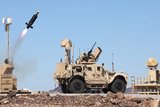Glimpses emerge of new Chinese heavy attack helicopter
The new helicopter platform will be more capable than the PLA’s Z-10 (foreground) and Z-19 (top right) attack helicopter platforms seen in this photograph. (Photo: Gordon Arthur)
Images of a new Chinese heavy attack helicopter performing flight testing began circulating on the internet in late March. Its nomenclature has not been officially revealed but it has been referred to by China watchers as the Z-21.
The helicopter’s maiden flight may have occurred in January, but the design’s most notable point has been its commonality with the Z-20 Black Hawk-lookalike utility helicopter of the PLA.
Andreas Rupprecht, author of multiple books on PLA aviation, told Shephard that rumours of a new attack helicopter have existed for a couple of years although these were of a stealthy Ka-52
Already have an account? Log in
Want to keep reading this article?
More from Air Warfare
-
![How do we detect and defeat enemy drones?]()
How do we detect and defeat enemy drones?
Learn about the portfolio of sensors and effectors for the complete counter-UAS mission at Raytheon, an RTX business.
-
![BAE Systems lauds counter-UAS drone progression with live fire trials]()
BAE Systems lauds counter-UAS drone progression with live fire trials
The US-based tests successfully demonstrated the first live trial of a precision guided missile from a modified TRV-150 drone which destroyed both aerial and ground targets.
-
![India readies private sector push as AMCA moves towards 2028 prototype]()
India readies private sector push as AMCA moves towards 2028 prototype
India’s stealth fighter ambitions gain fresh momentum as HAL opens the door to private sector involvement in AMCA Mk1A structural assembly, with strategic support growing for next-gen propulsion and sensor technologies.
-
![BAE Systems reveals new GCAP demonstrator design with plans to fly by 2027]()
BAE Systems reveals new GCAP demonstrator design with plans to fly by 2027
A key part in the trinational Global Combat Air Programme (GCAP), this is the first crewed supersonic aircraft demonstrator to be built and developed in the UK in more than 40 years.
-
![Kratos Defense makes European CCA push with Airbus partnership]()
Kratos Defense makes European CCA push with Airbus partnership
Kratos’ XQ-58A Valkyrie will be equipped with an Airbus-made mission system to be offered as a ‘European’ collaborative combat aircraft option to the German Air Force.
-
![Anduril’s Barracuda-100M completes latest successful test flights]()
Anduril’s Barracuda-100M completes latest successful test flights
The munitions variant of the Barrauda-100 autonomous air vehicle is being tested for the US Army’s High-Speed Manoeuvrable Missile (HSMM) testbed programme, with further flight tests expected in 2026.






















